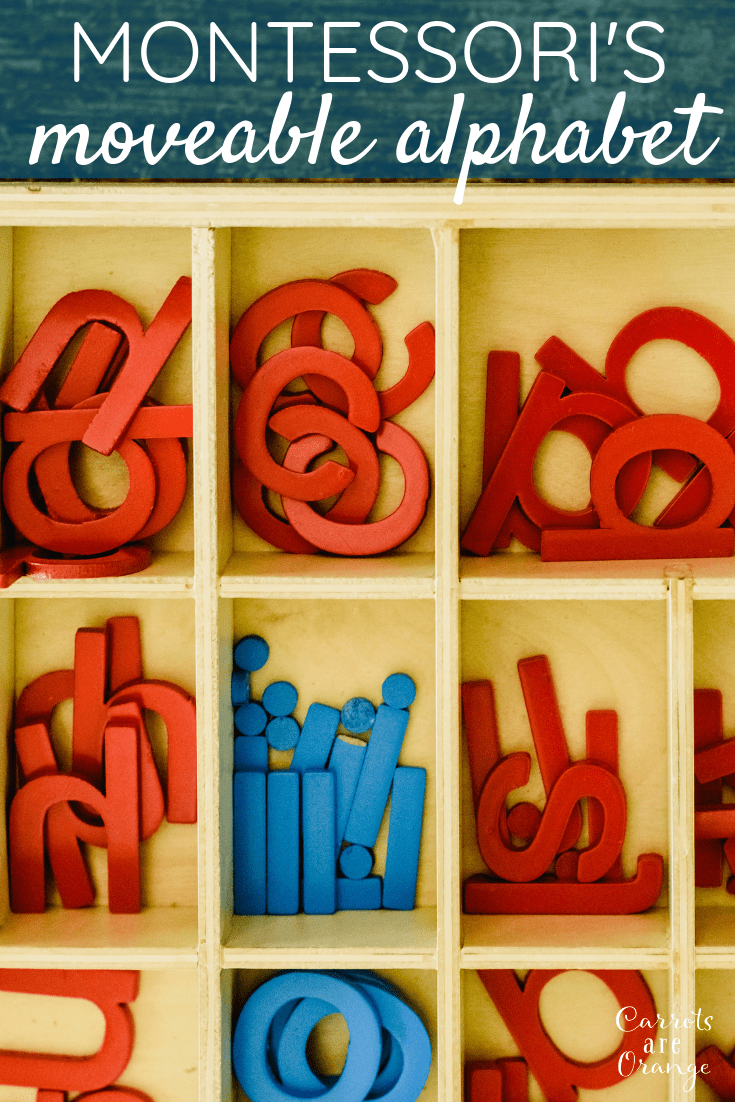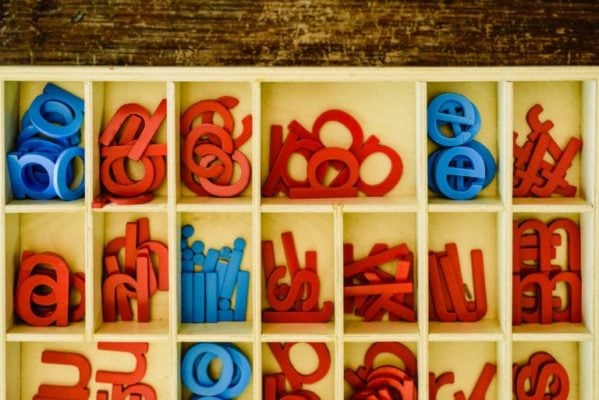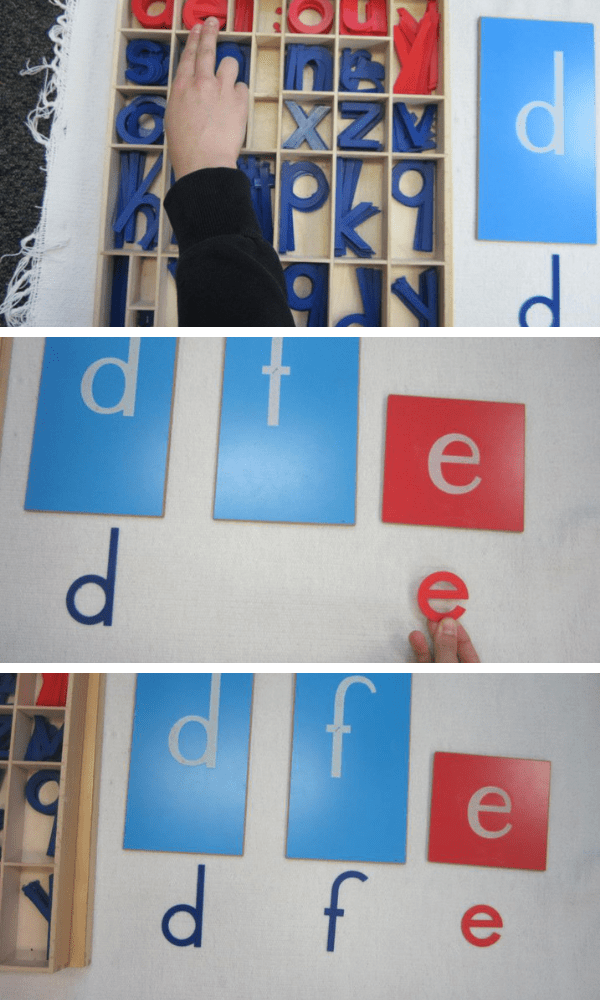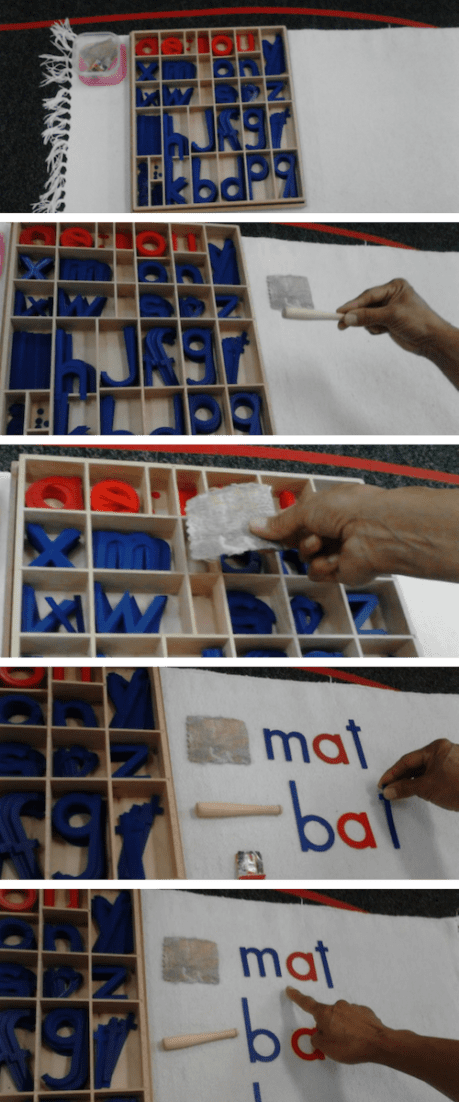How Will You Know Which Green Picture Box to Present to a Child First?
Montessori's Moveable Alphabet is an exciting transition for many immature children. Thus far in the Montessori Linguistic communication sequence of lessons, children have progressed using the sandpaper messages only. Once the guide presents the moveable alphabet, the children are eager to continue the learning.
Below are the Montessori lessons that use the moveable alphabet. The first lesson listed below is really the fourth lesson in the pinkish series sequence of lessons.

What is the Montessori Moveable Alphabet?
In brief, a moveable alphabet is a tool used in a Montessori learning surround to teach reading, spelling, and writing. It is a wooden box containing 26 wooden letters. Vowels are in bluish and consonants are in red.

Using the Moveable Alphabet with Montessori Language Lessons
- Introduction to the Movable Alphabet
- Clan of the Movable Alphabet and the Sandpaper Letters
- Short Vowel Discussion Edifice: Movable Alphabet and Sandpaper Messages
- Movable Alphabet: Brusque Vowel Words with Objects
- Movable Alphabet: Short Vowel Words with Pictures
#i – Introduction to the Moveable Alphabet
Typically the kid is 3.v years old or older when she starts using and learning with the moveable alphabet. Y'all know she is ready because she can recognize iii-4 consonant sounds and one vowel sound.
The goals of this lesson are to familiarize the child with movable alphabet, to teach care of the work past being careful with the letters, and by organizing & straightening letters in the box.

Nowadays the Moveable Alphabet with this approach:
- Invite the kid to exercise the work.
- Go to the shelf and carry movable alphabet to carpeting surface area.
- Give a proper name to the apparatus.
- Describe the contents within the wooden box.
- Allow child familiarize themselves with it.
- Demonstrate how to straighten letters in the box in guild to see them clearly; stacking same letters together in each compartment.
- Remove one or more letters and and then return to the box.
- Use scanning, left to right.
- Render letters to proper compartments and put back on the shelf.
The child will likely exist interested in the myriad of messages available to her easily. The blueish and reddish colors will appoint her, too. She will begin to place sounds to match the letters. The kid may also be interested in how the messages fit into the box's compartments so neatly (a control of mistake).
#2 – Association of the Movable Alphabet and the Sandpaper Letters
The next lesson in the sequence is associating this new tool, the moveable alphabet, with familiar material, the sandpaper letters. The age, readiness, and goals of this lesson are the same as when introducing the moveable alphabet. Similarly, age 3.v years quondam or older, having the ability to recognize 3-4 consonant sounds and ane vowel sound, and grooming for reading, writing, and spelling. Finally, for this presentation, you need only a mat, the sandpaper letters, and the moveable alphabet.

Acquaintance the Moveable Alphabet to the Sandpaper Messages with this arroyo:
- Invite child.
- Unroll rug if to exist used.
- Cull a sandpaper letter.
- Find the same letter from the moveable alphabet (or can remove a few to lucifer sandpaper messages).
- Place on or under the sandpaper alphabetic character.
- Keep depending on the kid'south interest.
- Return letters to movable alphabet box.
- Utilize scanning, left to right.
The child will exist interested in matching the letters. The command of mistake is that the messages don't friction match.
Related Read: Montessori Pink Series Word Lists
#3 – Movable Alphabet and Sandpaper Letters – Brusk Vowel Word Building
Once the guide introduces the moveable alphabet and associates the moveable alphabet with the sandpaper letters, the child is likely a fleck older, nigh iv years old or so, with the aforementioned prerequisites. The goals of this side by side lesson focus on club, concentration, coordination, independence, self-esteem, and preparation for writing, reading, and spelling.
Build Short Vowel Words with the Moveable Alphabet & Sandpaper Letters with this arroyo:
- Bring the sandpaper messages to the rugs
- Brainstorm with the consonant sounds and vowel sound the child knows, for case: (c, due south, m, t, a)
- Form a give-and-take the kid has previously read, such as "mat," with the Sandpaper Letters.
- Innovate the Large Moveable Alphabet to the child.
- Show the child how to browse box left to right, top to lesser with the index finger to find messages.
- Enquire the child to find the corresponding letters in the Moveable Alphabet.
- Evidence the child how to arrange the letters of the Movable Alphabet to class the word "mat."
- Ask the child to read the word he has formed.
- Continue with other words, such as: "cat," "sat," "rat."
- Prove the child how to render letters to proper compartments.
The child volition be interested in the different colors of vowels and consonants, the sounds, blending the sounds and letters, the colors of the vowels and consonants, and plumbing fixtures the letters into the corresponding compartments.

#4 – Movable Alphabet: Short Vowel Words with Objects
When the child is ready to move on from curt vowel discussion building, she will tackle the next lesson on the pink series sequence. The child will create short vowel words and match objects to the words.
For this lesson y'all demand the post-obit materials:
- Scarlet & bluish pencils (for writing on labels if the child is ready)
- Movable Alphabet and objects whose names are phonetic, carpet, work board, newspaper slips
- Containers of objects having the short vowel audio and the CVC pattern:
-
- /a/: bag, tin can, cap, cat, fan, pan
- /east/: bed, hen, jet, peg, pen, web
- /i/: bib, kid, chapeau, pig, pin, wig
- /o/: dog, play a trick on, log, mop, pop, top, pod
- /u/: bud, bus, cup, mucilage, jug, tub
Like aims every bit the prior lessons including:
- To begin forming and reading 3 alphabetic character brusk vowel phonetic words
- Social club
- Concentration
- Coordination
- Independence
- Self-esteem
- Analyze sounds in words
- Discussion building
- Preparation for reading
- Builds vocabulary
Match Short Vowel Words to Objects with this arroyo:
- Invite the child to work with the short vowel objects and the Moveable Alphabet.
- Show the child where the short vowel objects and the Moveable Alphabet are located on the shelf.
- Unroll rug
- Select the container with the brusque /a/ objects and the Moveable Alphabet and carry them to the rug.
- Proper noun each object.
- Kid repeats the name of each object.
- Identify the container of objects (/a/: pocketbook, can, cap, cat, fan, pan) to the upper left of the carpeting in a vertical column.
- Place the box of Moveable Alphabet letters to the right of the container of objects.
- Name the object: "carpeting".

- Brand the first sound of the object while pointing to each letter in the Moveable Alphabet box to locate the letter that represents the audio and place on the rug.
- Continue method, isolating each audio from word.
- Point to the object and proper name the object.
- Bespeak and movement the finger from left to right nether the word and read the word emphasizing the sounds of the word.
- Continue with the second object: bat.
- Continue the process every bit long equally the kid remains interested and focused.
- When words are formed, have the child read each word out loud.
- Remember not to correct whatever misspelled words.
- When set to return the material to the shelf, begin with the object at the left. Proper noun the object and return to container.
- Read the discussion and return each alphabetic character to the appropriate compartment.
- Render the objects and Moveable Alphabet to the shelf.
The kid volition be interested in exploring the objects, placing the letters in a row to brand a word, the colors, the sounds, associating the sound and the letter, reading the words, reading the written words, and writing the words.
#five – Moveable Alphabet with Short Vowel Words & Pictures
In one case the child masters matching the objects to short vowel words built with the moveable alphabet, he is gear up to motion a bit more than abstruse. In this lesson, the kid volition build short vowel words with the moveable alphabet and match pictures (instead of objects) to the words.
Materials needed for this lesson include:
- Movable Alphabet and pictures whose names pencils (red and blue) are phonetic, carpet, work lath, paper slips,
- Containers of pictures having the short vowel sound and the pattern consonant/vowel/consonant:
- /a/: bag, can, cap, cat, fan, pan, gas, ham, jam, rag, rat, tag
- /e/: bed, hen, jet, peg, pen, web, keg, leg, men, red, ten, hem
- /i/: bib, child, lid, squealer, pin, wig, fig, fin, hip, rib, tin, lip
- /o/: canis familiaris, play tricks, log, mop, pod, superlative, cob, cot, hog, rod
- /u/: bud, double-decker, cup, glue, jug, tub, bun, mud, pup, rug, dominicus, problems
The goals for this lesson include:
- To begin forming and reading three alphabetic character short vowel phonetic words.
- Order, concentration, coordination, independence
- Self-esteem
- Analyze sounds in words
- Discussion building
- Preparation for reading
- Builds vocabulary
Match Curt Vowel Words to Pictures with this approach:
- Invite the kid to work with the curt vowel pictures and the Moveable Alphabet.
- Show the child where the brusque vowel pictures and the Moveable Alphabet are located on the shelf.
- Unroll carpet
- Select the container with the short /a/ pictures and the Moveable Alphabet and comport them to the rug.
- Place the container of pictures (/a/: purse, can, cap, cat, fan, pan) to the upper left of the rug in a vertical cavalcade.
- Place the box of Movable Alphabet letters to the right of the container of pictures.
- Proper name the picture: cat.
- Make the get-go sound of the picture while pointing to each letter in the Moveable Alphabet box to locate the letter of the alphabet that represents the sound and place on the rug.
- Continue method, isolating each audio from the discussion.
- "C", scan, remove the letter from box and place on the rug.
- "a", scan, remove the letter from box and place on the rug. Identify the letter of the alphabet to the right of the first letter.
- "t", scan, remove the letter of the alphabet from box and identify on the rug. Identify the alphabetic character to the right of the second letter. Notation: Letters tin can exist pre-selected and laid randomly on the lesser of the rug.
- Point to the picture and name the picture.
- Point and motility the finger from left to right under the give-and-take and read the word emphasizing the sounds of the word.
- Go along with the 2nd picture: tin.
- Go on the procedure equally long as the child remains interested and focused.
- When ready to return the material to the shelf, begin with the object at the left. Name the object and return to container.
- Read the word and return each letter of the alphabet to the appropriate compartment.
- Return the objects and Moveable Alphabet to the shelf.

Resources Used in these Moveable Alphabet Lessons
- Wooden Box Moveable Alphabet
- Original Sandpaper Letters
- Small Objects for Language Learning
- Padded Blank Labels
- My Favorite Colored Pencils
- Work Rug
Related Read: All Y'all Need for an Easy Sandpaper Letters Lesson
Marnie hails from Maine where she spent summers buried in sand and winters buried in snowfall. She is the girl of a well-nigh four decade veteran of the public school systems. Educational activity has always been a part of her life. She founded Carrots Are Orange in 2010.
Carrots Are Orange is a Montessori learning and living website for parents and teachers.
Marnie graduated from Wesleyan Academy in 1999 with a BA in Economics. She spent near a decade working in investment direction. In 2006, she earned her MA in business organisation from the University of Washington's Foster School of Business organization.
Marnie moved to the w coast in 1999 and currently lives in Boulder with her husband and three sons. She is Montessori trained. Her piece of work has been featured on Apartment Therapy, Buzzfeed, PBS Kids, BabyCenter, the Melissa & Doug weblog, Huffington Post, and WhattoExpect.com. Besides writing, passions include running (usually after her three sons), photography, and outdoor adventures.
williamsanter1952.blogspot.com
Source: https://carrotsareorange.com/moveable-alphabet-lessons/
0 Response to "How Will You Know Which Green Picture Box to Present to a Child First?"
ارسال یک نظر